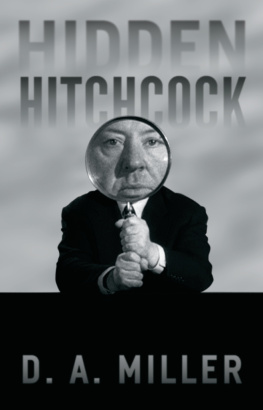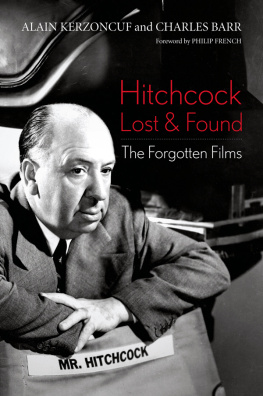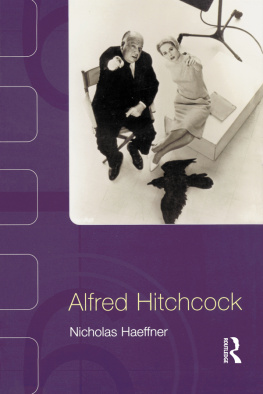
Alfred Hitchcock and the Making of Psycho
Stephen Rebello

TO MY FAMILY,
who keep me honest.
Film should be stronger than reason.
ALFRED HITCHCOCK
1.
The Awful Truth
The Atrocities of Ed Gein
There was a young man named Ed
Who would not take a woman to bed
When he wanted to diddle,
He cut out the middle
And hung the rest in a shed.
ANONYMOUS, 1957
IN LATE NOVEMBER 1957, NO one would have marked Plainfield as unlike any other hardscrabble, rawboned Wisconsin farm hamlet. That winter was especially raw. Ask any of the friendly townies of third- and fourth-generation German and French stock. In flat, laconic tones, they recite litanies of burst water mains and permafrost; of nights spent hunkering down against slashing winds and rains that blew east along Canadas border. But that November also saw Plainfield mentioned in newspapers across the country. Remind these dairyland types about that little bit of business and their open faces wall up. They begin to study their shoes or make excuses before they beg off. That month, in 1957, Plainfield police smoked out an oafish fifty-one-year-old, odd-job-and-errands-man named Ed Gein (rhymes with mean) as one of the grisliest mass murderers America ever spawned.
Long before the headlines were to brand Gein as a bogeyman, his rural, God-fearing community of seven hundred had chalked him off as a crank. A perpetually grinning, unmarried recluse, Gein rambled over 160 ruined acres once farmed by his parents and brother. Even locals who never gave a second thought to hiring Gein for errands or baby-sitting had wearied of his harebrained theories. He liked to rag on the whys and wherefores of criminals who fouled up, or yammer endlessly, and pitifully, about women. Plainfield-ers recall his clinical obsession with anatomy and with the sex-change operation of Christine Jorgensen. But there was more to Gein than loony talk. That came home with a vengeance with the discovery of bloodstains on the floor of Bernice Wordens general store on November 16.
Customers had marked it as odd that Wordens store had been closed since before noon that Saturday, her busiest day. No one had seen the steady, well-liked storekeeper since the previous day. Her pickup truck was missing from its usual spot. Concerned, Wordens deputy sheriff son, Frank, let himself into the store. A late entry in Wordens sales book ( gall. antifreeze) triggered Franks recollection of Ed Geins loafing about the store the previous week. Gein had asked whether Frank would be out deer hunting on Saturday. When Frank answered that he would, Gein casually mentioned he might be back for a can of antifreeze.
On Frank Wordens tip, Sheriff Art Schley and Captain Lloyd Schoephoerster made tracks for Geins lonesome, decaying hermitage. The hand of death had first passed over the stark farmland when Geins father succumbed to a stroke in 1940. Four years later, a fire claimed the life of Eds older brother, Henry, and, the following year, Geins hellfire-and-brimstone-spouting mother met her maker, too. Now, Gein lived aloneor so it had seemed.
Gein was elsewhere when the law came to call. Schley and his officers lighted the way with kerosene lamps and flashlights; the old house was only partly jerry-wired for electricity. The lawmen picked their way through a rats nest of browning newspapers, pulp magazines, anatomy books, embalming supplies, food cartons, tin cans, and random debris. Upstairs, five empty, unused rooms slept under blankets of dust; by contrast, the bedroom of Geins late mother and a living room, both nailed shut, were kept pristine.
Raking the rubble of Geins kitchen and bedroom, the officers uncovered sights for which no highway wreck or Saturday night special shoot-em-up had prepared them. Grinning, loose-toothed Ed Gein did not live alone, after all. Sharing his abode were two shin bones. Two pairs of human lips on a string. A cupful of human noses that sat on the kitchen table. A human skin purse and bracelets. Four flesh-upholstered chairs. A tidy row of ten grimacing human skulls. A tom-tom rigged from a quart can with skin stretched across the top and bottom. A soup bowl fashioned from an inverted human half-skull. The eviscerated skins of four womens faces, rouged, made-up, and thumbtacked to the wall at eye level. Five replacement faces secured in plastic bags. Ten female heads, hacked off at the eyebrow. A rolled-up pair of leggings and skin vest, including the mammaries, severed from another unfortunate.
In the adjacent smokehouse shed, police found what they would later identify as having once been Bernice Worden. Nude, headless, dangling by the heels, she had been disemboweled like a steer. Sitting atop a pot-bellied stove in the adjacent kitchen was a pan of water in which floated a human heart. The freezer compartment of the refrigerator was stocked with carefully wrapped human organs.
I didnt have anything to do with it. I just heard about it while I was eating supper, mumbled Gein when Frank Worden located and confronted him about the discovery of Bernices corpse. Worden arrested Gein on the spot. In no time flat, Plainfields Caspar Milquetoast underwent a lie detector test, a murder charge, and psychiatric examinations at Central State Hospital for the Criminally Insane. Until then, no one had credited the mutterings of a shiftless crank about his collection of shrunken heads. No one paid any mind to his inside knowledge of the areas many unsolved disappearances of women. The Gein farmhouse offered testimony not only to mans fathomless capacity for the barbaric, but also to the ability of an entire community to deny its very existence. It cant happen here, insists the satiric lyric of a Frank Zappa song, Help Im a Rock. The here in question is the human heart and mind.
Gein met the probing of his examiners with barely audible, monotone ramblings. His memory was murky. He admitted to only two murders, claiming he was in a daze during both. No law officer, psychiatrist, or court examiner could penetrate Geins motivations. Yes, he admitted to dismantling Bernice Wordens cash register and removing $41. Yes, he had also exhumed his first cadaver with a farmer crony, Gus. Yet his rationale for both was identical: He liked taking things apart to see how things work.
Deep in the night, while his hard-working neighbors made love, snored, studied the Good Book, and fretted over bills, bland, simple Ed Gein delved into the mystery of how things worked by traipsing around the farm with the skin, hair, and face mask of newly exhumed corpses strapped to his naked body. Authorities discovered that Geins first graveyard visit led to forty-odd other digsalways graves of femalesoften just a stones throw from the final resting place of his mother. He told his examiners that he and Gus (who had died several years earlier of natural causes) buried the bones and incinerated less-interesting body parts in the Gein stove. When newspapers reported that Gein claimed I never shot a deer, how many locals shuddered at the memory of plastic bags packed with tasty venison given them by Gein?
Gein made his first kill in 1955 when, late one bitter winter night, his .32 rifle drew a bead on a bosomy, fifty-one-year-old, divorced tavern owner. Using a sled, Gein dragged the body of Mary Hogan to his summer kitchen shed. Police suspected Gein of torturing and murdering at least ten other victims between Mary Hogan and Bernice Worden. He never owned up to them before being judged criminally insane and sentenced to life at Central State Hospital.
Next page












